Friday the 13th is notorious for those who believe in bad luck, but do we ever consider the bad luck to animals in the same way?
On Friday 13th April, we went to a local bird farm to pick up some more dust free wood chippings to line the bottom of our finch cages, and we popped into the sale section to see the variety of birds. We were pleased to see the store had a wider range of finches than before, including St. Helens finches, but there was one finch that caught our eye.
At the bottom of the cage, sat on a gridded bottom was a small, young, female Zebra finch. She appeared to have no tail. We watched her as she struggled to move and fly, and it seemed she couldn’t get to the food and water bowls hanging higher up on the side of the cage.
Now, in the past on many occasions, we have seen injured and/or impaired finches, and have wanted to save them from their unfair circumstances, take them home and give them a tailored life to meet their needs, but we haven’t had the ability, for one reason or another, to do so. And every time we have to walk away, we end up feeling sad and worried for that bird we left behind.
But not this time. 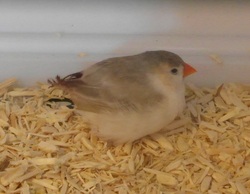 Celestine Day 1 This little finch was young, as others in the cage still had the black patches on their beaks, and we were told they were all about the same age.
We bought the Zebra finch and took her home. With the cage set up we let her out and the reality dawned on us.
This little Zebra finch did have a tail once, but it had been plucked out, and she had several quills bleeding - so much so there was blood all over the box we rushed her home in. The little finch must have bled a lot, as her wings were caked in blood, and the ends stuck so tightly together that she couldn’t stretch them to fly!
We ended up having to pull out the bleeding quills as we couldn’t get the bleeding to stop, even with blood stop sticks, and we used a damp cloth to gently clean her wings. Though it didn’t clear up all the blood, it softened it enough for her to free her wings and clean herself. At this check up we also realised that she is missing her back toe on her left foot. It looks to have been cut off at some point, possibly from the grid on the bottom of the cage she was in.
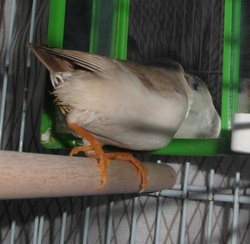 It is now day 5 and our little Zebra finch is doing great. She is active and friendly, enjoys music and loves the millet, egg food and cucumber we give her.
So far however, it seems she does not understand that you can get water from the water bottles, as she keeps drinking from the moist cucumber slices, and she struggles to de-husk finch seed (again making us think she is very young and not fully weaned), but she is getting there.
We have put all her food in shallow bowls on the bottom of the cage, as she was also struggling with hanging feeders, even with her wings freed up.
We are very happy to have saved this particular finch. It seems the little Zebra finch may be a female Fawn Penguin Zebra finch, which so far we have never seen, and we have decided to call her Celestine.
While Friday the 13th is believed to bring bad luck to some, and the day hadn’t started off nice for this little finch, it seems our arrival gave her hope, as she now lives a better life.
Well this morning was eventful.
Yesterday Florence was looking a bit ‘off’. We couldn’t put it down to anything, I couldn’t feel a stuck egg and there was nothing visibly wrong with her. We gave her a heat lamp and let her rest. This morning we woke up to find her looking much worse and her vent covered with sticky yolk-like goo. Looks like she was egg bound after all and the egg had ruptured :(
If an egg ruptures inside a bird it can be very serious – leading to something called Egg Peritonitis. We rushed her to a vet (after having a bit of a panic to try and find her an avian vet) and she is on a course of antibiotics. We are hoping she gets better soon
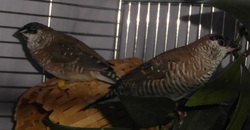 Over a week ago we found out that Little Petra, one of the Cherry finch fledglings that we thought was female, turned out to be male. Well, Cassi, the other Cherry finch fledgling has now moulted, and it turns out Cassi is also a male! In order to avoid us confusing him with Orion, we have given Cassi a yellow band on his left leg.
Female Cherry finches will have white eyebrows, while a male Cherry finch will not have white eyebrows and will have a black bib under their beak. It seems that male Cherry finch chicks look like female Cherry finches (minus the adult chest plumage).
Also, so far we had thought that only 2 of our 10 Society finch fledglings were male. However this weekend Comet (one of Donovan’s lighter brown fledglings) decided to start singing. He is not very good, but sings a lot lately.... So it would seem Comet is also male!
Seeing as Comet took so long to begin singing, it is possible more of our Society fledglings may turn out to be Male.
The website's gallery page has undergone minor changes today to allow us to add even more new images while being internet friendly. Instead of just one gallery page, hovering over the tab will now give a dropdown list so that we may essentially archive the older images while still making them available to the public.
As such, keep checking this space as we intend to update the gallery more regularly than ever!!
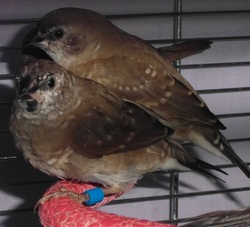 With our Cherry and Bengalese chicks now 2 months old, they have began moulting and the Cherry finches are slowly gaining their adult colours.... and it seems Little Petra is in fact a male, as he has developed a bib under his beak, sings a lot and the pale eye brows are disappearing. Petra’s bib started coming through a few days ago, and Cassi isn’t changing despite hatching the same day.
As such, it seems that both male and female Cherry finch fledglings will look the same, and both will look female. They begin moulting at 2 months into their adult colours. It is quite important we share this information, as it seems there is a limited amount of information available on the internet about Cherry finches.
Our Cherry finches are quite confident when it comes to bath time, and enjoy getting themselves completely soaked. They enjoy their egg food, as well as the cucumber, broccoli and cauliflower we feed them. They are similar to Bengalese finches in that they enjoy the silk plants/leaves and will interact with them regularly. Also, our Cherry finches do not appear to like bought bird nests (wicker basket or hollowed coconut).
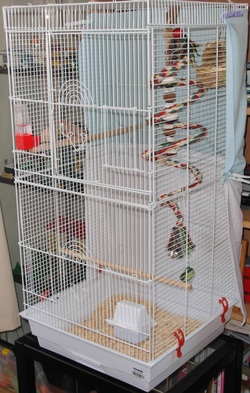 Following on from yesterday’s post, we managed to find a new cage for the Zebra finches today. While normal bird shops tend to only sell larger cages for larger birds (bar spacing too large for a finch), we went to a farm with its own bird shop and aviary section, where we could get larger cages with small bar spacing.
We ended up buying a cage 44cm x 44cm x 94cm (L x W x H) which was surprisingly cheap compared to most regular pet shops selling smaller cages for more money. It came with 3 wooden perches and 4 plastic enclosed food bowls. The cage also has a slide out tray which is a must have for keeping your bird’s home hygienic with minimal stress to them. While the cage is tall, it has a larger base surface area than our smallest cage, which was what we were mainly after. And to combat the excessive height, the cage has been designed so that half the height can be taken out by removing a horizontal section.
We managed to move the Zebra finches and their spiral perch and nest to the new cage. The Zebras were not happy with the move at first, but they seem happy with the new cage now, and haven’t given up on their nest which is a good thing.
We have now moved the four Cherry finches and two of the Bengalese finches (Theo and Peppi) to the large cage the Zebras were previously in, and reshuffled the remaining Bengalese finches amongst the other two large cages. To help prevent the adults from breeding with each other again, we have Donovan, Luna, Lilly, Ecco, Comet and Freya in one cage, while Apollo, Cosmos, Dune, Demitri, Aquila and Isobelle in the other cage.
We have also put hygienic and dust free wood chippings in the bottom of each cage as well. It came in an 18 litre bag. The bag of chippings appears to be specially designed for birds, and the farm we got it from said they have always used it themselves for the finches they keep and sell. Our finches appear to appreciate it. We were concerned at first that the birds might have been trying to eat it, but it seems they are just playing with it like they do when they get hay.
To start, a Society finch is the American name for a Bengalese finch, most likely due to their sociable nature. They are supposed to be friendly and docile, but one of our Bengalese finches definitely is not social. If you have read the original post, you would be right in guessing that we are talking about Luna.
Following her feuds with Darwin when we first got Luna and Donovan, Luna went from being a shy and cowardly finch to a fighter. Since Apollo managed to breed with her and she had her four chicks, she has become a bit more social, but only to Donovan and her own children.
Two nights ago, Luna had been stopping any of Donovan’s children from entering the nest at night to sleep, though once Donovan forced Luna to the back of the nest it was no longer a problem. However, last night Luna must of been going over the top, cause she was properly attacking any of Donovan’s children once they got into the nest (we could hear them screeching in fright). As such, we had to remove the nest last night.
So, last night they all lined up on the silk vines hanging along the back of the cage and slept in a row. That is, all but Luna, who decided to sleep in the food bow, which is pretty much the furthest point you can get in the cage from where everyone else was.
Now, we know that cage is a bit cramped, 10 finches in a 120cm by 50cm by 50cm cage (L x W x H), and we had been discussing getting a new cage for a while. Initial indications suggest the nest was the cause, as Luna must have wanted it to lay more eggs, because now it is removed there has been no bickering or fighting as of yet today. Never the less, it is time to get a new cage.
Now, we already have 3 large cages ideal for 6 birds each, and one small cage apparently ideal for 2 birds, making 20 in total which matches how many we currently have, but we want our birds to have more length to fly and exercise, so the small cage is reversed as the sick cage only.
The aim is find a cage ideal for 4 finches (in length), so that we can move our 2 Zebra finches across. However, they are currently sitting on eggs (preliminary checks suggest they are all infertile, which is a shame, but at least it does not add more problems later on). So in the mean time, we will most likely move the 4 Cherry finches, or all 4 adult Bengalese finches to the new cage temporarily, while we wait for the Zebra finches to give up on their eggs so that we can make the switch between cages.
In the mean time, it is actually quite hard to find a cage with a base area larger than 50cm by 50cm which is suitable for 4 finches. Most cages either end up being all about height (which finches do not really utilise), or the bar spacing is too big. Also, we currently do not have the room for another large cage ideal for 6 finches, so getting another one like the ones we currently have is out of the question.
Well, fingers crossed we’ll find one soon.
If you haven't seen it already, a new page has been added today to show off the wild birds that come to our garden to feed on a daily basis. Most of the birds appear to come for the Sunflower Hearts we supply, so we have to keep topping up that feeder every other day. It is costly, but we feel it's worth it. Please see the new page for more details.
We feel it is important to support wild birds, though if you do decide too as well, it is extremely important to keep it up, as some wild birds, which maybe wouldn't survive naturally, do become dependant on you for food.
Our two Zebra finches, Florence and Darwin were our first finches, and when the Bengalese and Cherry finches were sitting on eggs in January, we also let the Zebras keep their eggs, but sadly they were unsuccessful to hatch any chicks.
Since then, the Zebras were moved to the original large cage to allow us to divide up the Bengalese and Cherry finches, once the fledglings had become independent.
Recently we have now put a nest at the top of the spiral rope, and one side of the cage is now decked out with new silk leaves. Unsuprisingly, the Zebras are happy enough to attempt to another round of egg laying. However, it seems they are really going for fertile eggs, if you know what we mean!
The egg can be seen in the top picture, while the new silk leaves can be seen in the bottom picture. The large leaf shown is quite sturdy, and can easily support the weight of a few finches, though we are yet to see the Zebras try.
And while on the theme of Zebra finches, we have also added two new short videos to the Video Centre page, one of Darwin having a bath, then one of Florence also having a bath. | |
Today we captured this rather nice picture of Luna, hanging out with her four children. With them sat on the silk vines hanging along the back of the cage, their tails are cutely poking up in the same direction.
From left to right we have:
1) Dune
2) Isobelle
3) Freya
4) Luna
5) Cosmos | |
|





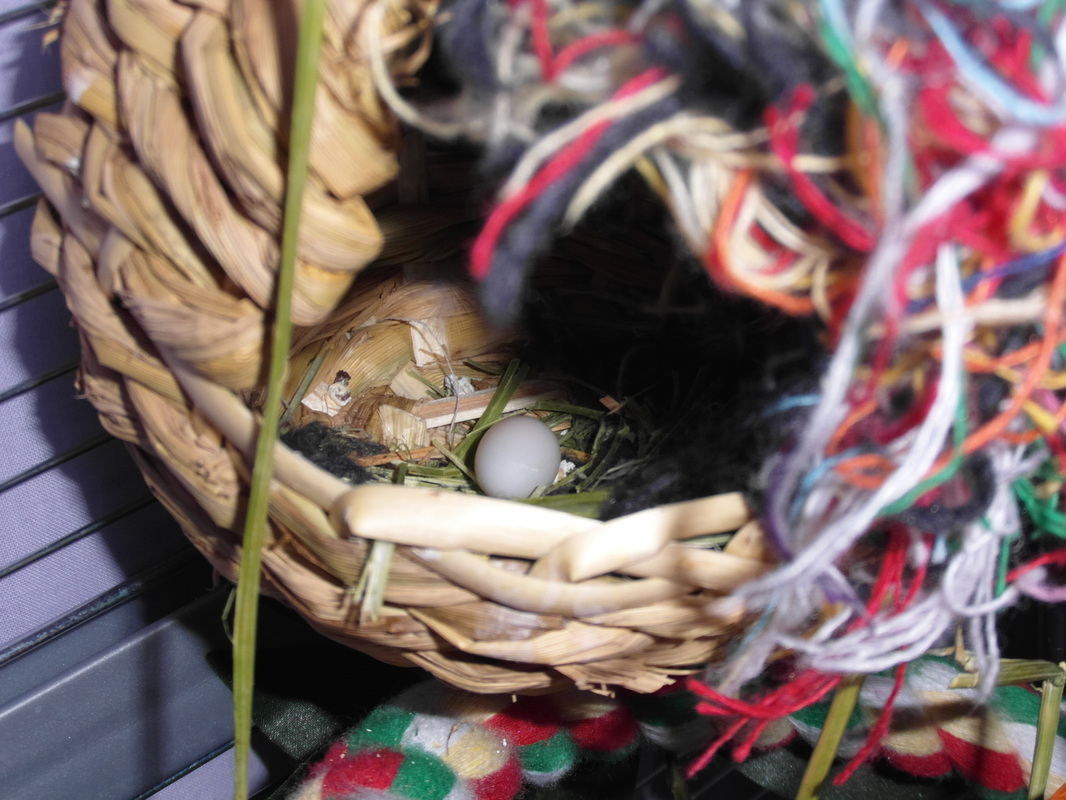
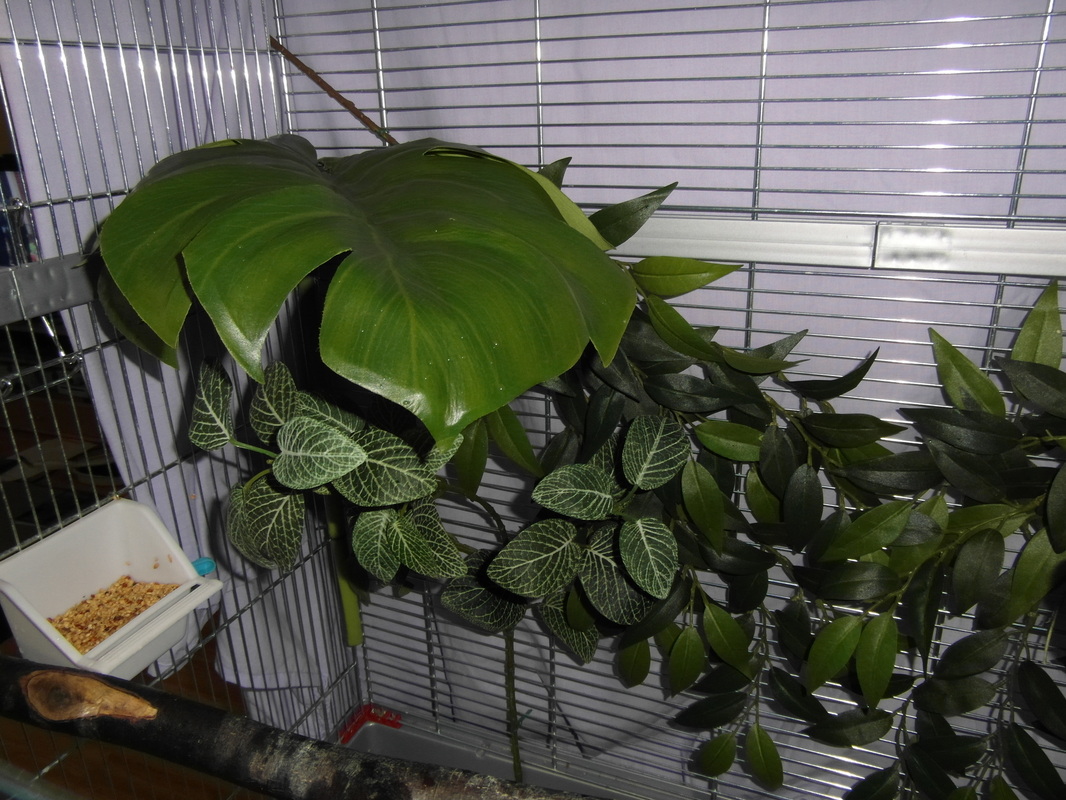
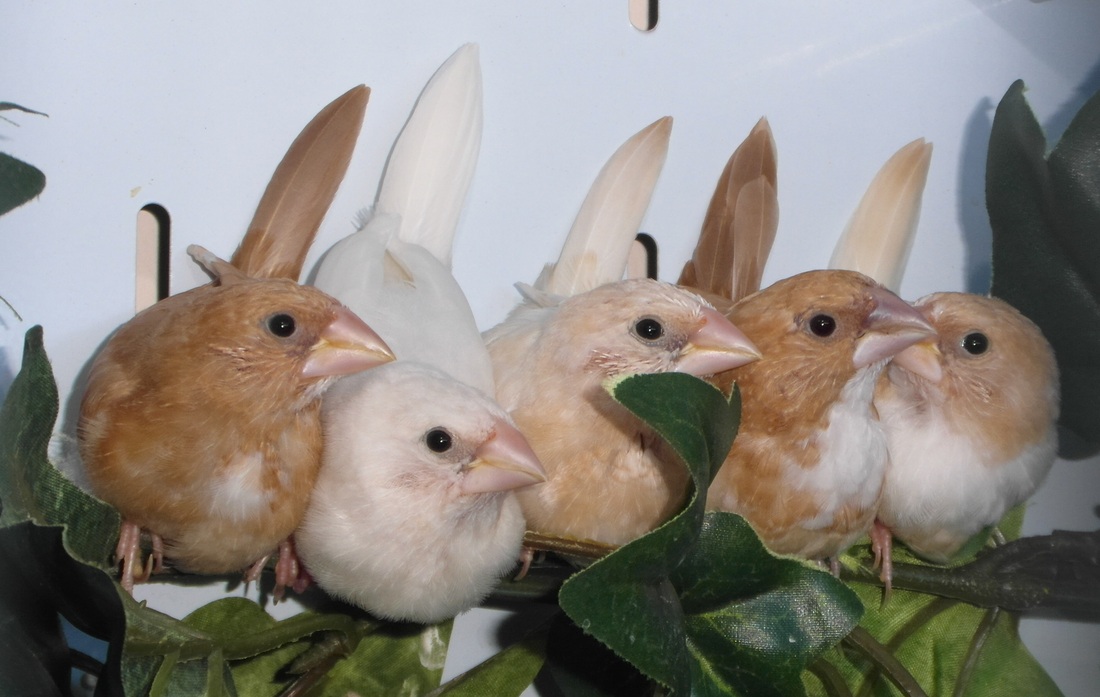
 RSS Feed
RSS Feed